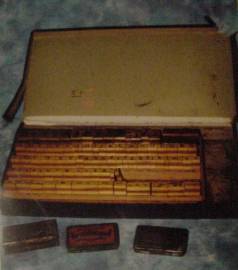
Letter Codes
In shops people would use letter codes instead of figures for marking prices. The shop assistant would have to learn these letter codes.
In Houlihans in Ballyragget, the letters were:
I AM THY LORD = 1 23 456 7890
e.g. FLOUR - 1/7 = I/L
In Muldowneys shop in Corbettstown the letters were:
CAMPER DOWN = 123456 7890
e.g. MEAT - 5/2 = E/A
Shop Printing Set
This printing set was used for marking special offers and prices long ago.
Old shop keepers used these sets for their shops. On the following page we have
shown some of the lettering from the printing set.
Source: Kieran Costello.
Bicycle Stand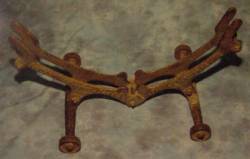
This stand was used for displaying bicycles outside shops. It could be folded
up and taken away when not in use. You can see where the wheel fitted in.
Source: Richard Eyre.
Shopping
In the following tables we compare shop prices from Delaneys shop in Lisdowney in the years 1905-07 with prices from Byrnes shop in Freshford in 1938. The book which we were given from Delaneys shop also show some peole paid part of their grocery bills in butter and eggs. The shop sold everything from bread to pollard and from snuff to rabbits.
The book from Byrnes shop shows how much prices had increased in about 30 years. It did not seem to sell the same range of goods as Delaneys.
Lisdowney Shop Prices (1905 and 1906)
These prices are from the ledger of Edward Delaneys grocery shop in Lisdowney for the years 1905 and 1906.
The following are prices of some of the items sold in the shop:
|
Item
|
Price
|
Modern Equivalent
|
|||
|
L.(Pound)
|
s.(shilling)
|
d.(pence)
|
€
|
c.
|
|
| Loaf of bread | 2 | 1 | |||
| 1/2 lb. butter | 6 | 3 | |||
| 1 lb. sugar | 2 1/2 | 1 | |||
| 2 lb. sugar | 4 | 2 | |||
| Pot of jam | 6 | 3 | |||
| 1/4 lb. tea | 8 | 4 | |||
| 1/2 lb. tea | 1 | 4 | 8 | ||
| 1 stone flour | 1 | 7 | 10 | ||
| 1 dozen eggs | 7 | 3 | |||
| 1 lb. meat | 7 | 3 | |||
| 9 lb. meat | 5 | 2 | 31 | ||
| 1 stone pollard | 10 1/2 | 5 | |||
| 4 stone pollard | 3 | 2 | 19 | ||
| 1 stone meal | 10 1/2 | 5 | |||
| 8 stone meal | 6 | 4 | 38 | ||
| 1 oz. tobacco | 3 | 1.5 | |||
| Clay pipe | 1 | 0.5 | |||
| Matches | 1 | 0.5 | |||
| Pig's head | 1 | 8 | 10 | ||
| Bag of salt | 3 | 1.5 | |||
| Large bottle of Oil | 1 | 0 | 6 | ||
| 2 stone of bran | 1 | 6 | 9 | ||
| 1 lb. soap | 2 1/2 | 1 | |||
| 1 Candle | 1 | 0.5 | |||
| 1 Stamp | 1 | 0.5 | |||
| Washing powder | 2 | 1 | |||
| An Orange | 1 | 0.5 | |||
| A Rabbit | 6 | 3 | |||
| 1 dozen Herrings | 4 1/2 | 2 | |||
| 1 oz. snuff | 5 | 2.5 | |||
| Caraway seeds | 1 | 0.5 | |||
| 1/2 lb Currants | 2 | 1 | |||
| 1 oz. Turpentine | 1 | 0.5 | |||
Source: Larry Hamilton.
Freshford Grocery Shop
These prices are from Byrnes grocery shop in Freshford for the year 1938.
These are some of the items sold in the shop:
|
Item
|
Price
|
Modern Equivalent
|
|||
|
L.(Pound)
|
s.(shilling)
|
d.(pence)
|
€
|
c.
|
|
| Bread | 6 | 3 | |||
| 1/4 stone Sugar | 11 | 5 | |||
| 1/2 gallon Oil | 5 | 2.5 | |||
| 2 oz. Tobacco | 1 | 6 | 9 | ||
| 1/2 lb. Tea | 1 | 6 | 9 | ||
| 1/2 doz. Eggs | 6 | 3 | |||
| 1/4 lb. Tea | 9 | 4.5 | |||
| 2 lb. Sugar | 2 | 1 | 12 | ||
| Matches | 3 | 1.5 | |||
| 1 lb. Butter | 1 | 4 | 8 | ||
| 1/2 stone meal | 1 | 2 | 7 | ||
| 2 stone Flour | 2 | 6 | 15 | ||
| Pot of Jam | 11 | 5.5 | |||
| Custard | 2 1/2 | 1 | |||
| 1 stone Flour | 2 | 6 | 15 | ||
| Candles | 3 | 1.5 | |||
| 2 lb. Bacon | 2 | 8 | 16 | ||
| 1 cwt. Coal | 2 | 10 | 17 | ||
| 1/2 lb. Bread Soda | 1 1/2 | 1 | |||
| Shoe Laces | 1 | 0.5 | |||
| Cocoa | 6 | 3 | |||
| Clothes Pegs | 3 | 1.5 | |||
| 2 1/2 lbs. Ham | 3 | 4 | 17 | ||
| Salt | 2 | 1 | |||
| 4 1/2 lbs. of Pig's Head | 2 | 3 | 13 | ||
Source: Veronica Doheny.
Local Shops of the Past
Geoff Brennan told that early in the century there was a public house at Ballybrophy Cross (opposite St. Lactain's Cemetery) and a shop at Balleen Cross. He also remembers his father talking about a shop at Ballyring (near where O'Brien's lane is now).
Both Geoff and John Costelloe remember hearing the old people say that the house opposite Clontubrid Church (which was the curate's house unitl the 1960s) was once a public house (about 100 years ago). John Costelloe also believed that there was a shop a Clontubrid.
Mick Grace remembers a shop at the gate lodge to Mount Eland House which was owned by the Sparrow family. There is no evidence of shops at any of these places now.
Tobacco Knife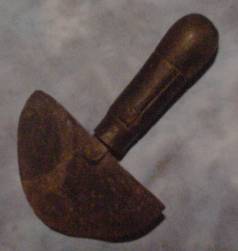
A tobacco knife was used to cut the plug tobacco from a slab of tobacco. Most
pipe smokers used to buy plug tobacco by the ounce. It was 3 p for one ounce
of tobacco around 1905. Tobacco was often bought by the "halfquarter". There
were 16 ozs in a pound (lb) so a "half quarter" was 2 ozs.
Source: Tony Coady.
Tobacco Cutter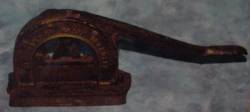
This tobacco cutter was used to cut the plug tobacco in ounces.
Source: Kieran Costelloe.
Club Bottles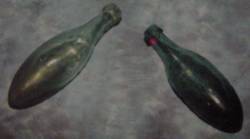
These bottles were used for minerals. They were called club bottles because
they were in the shape of clubs. Some old people told us that the name "Club
Orange" came from those bottles.
Source: Dennis Hamilton.
Delaneys Shop 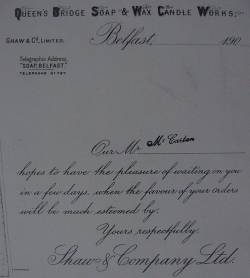
This photograph shows a letter from Shaw and Co., Belfast, the Queen's Bridge Soap and Wax Candle Works, stating that their salesman would be calling in the near future. The salesman's name was Mr. Cartan.
The text of the letter is interesting, it reads:
"Our Mr. Cartan hopes to have the pleasure of waiting on you in a few days, when the favour of your orders will be much esteemed by,
Yours respectfully.
Shaw and Company Ltd."
The letter was addressed to Miss Kelly who was probably the shop assistant.
It is dated April 30th 1909.
Source: Larry Hamilton.
Shop Signs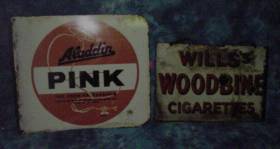
These two signs for Aladdin Paraffin Oil and Woodbine cigarettes were from
Delaneys shop in Lisdowney.
Source: Tony Coady.
Mortar and Pestle
This mortar and pestle were used by chemists for mixing powders, herbs and
medicines.
Source: Kieran Costelloe.
Chemists Scales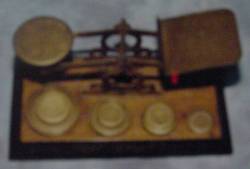
This was used by chemists for weighing medicine it also includes a set of brass
weights.
Someone else thought that it was used by the Post Office for weighing mail.
Source: Kieran Costelloe.
Bottle Filler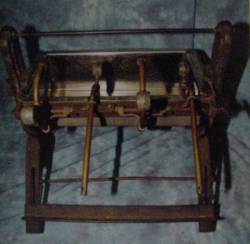
Tony Coady told us that this unusual looking invention was used in public houses
to fill bottles of beer from a barrell. The beer flowed from the barrell into
the resevoir (top). This stainless steel one is not the original. The beer was
then siphoned through the copper pipes into the bottles. Each pipe had a weighted
handle to lower or raise it. When a bottle was full the pipe was raised. The
other end dropped into the tank and there was a rubber seal on the end to stop
the beer flowing.
Source: Tony Coady.